This post may contain affiliate links.
Known for their playful personalities, bizarre behaviors, and eye-catching appearance, Clown Loaches are one of the most endearing tropical freshwater fish. The Clown Loach is the staple of community tanks, but keeping these botiidae requires a serious commitment as they can grow to the size of a foot-long sub and can live up to 20 years. To ensure the well-being of Clown Loaches, certain requirements must be met. Wondering what those are?
The following is a detailed 101 care guide that covers the nitty-gritty of maintaining a healthy Clown Loach aquarium. Be it setting up a suitable habitat, choosing compatible tankmates, what to feed, or common Clown Loach health problems, we have covered almost everything you would want to know about raising these delicate and slow-growing giants.
A Closer Look at Clown Loaches – A Brief Overview
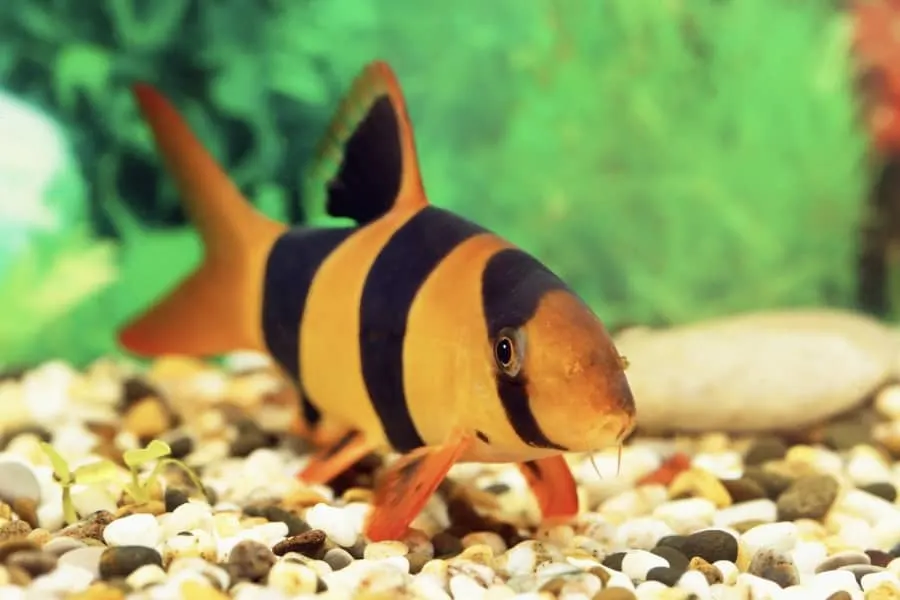
The only objective of this particular section is to make you familiar with the Clown Loach.
Origination and Naming
Native to Indonesia, Clown Loach (Chromobotia macracanthus) is a tropical freshwater fish that originates in inland waters on the islands of Sumatra and Borneo.
The Loach is referred to as “clown” due to its coloration and unusual behavior patterns such as sleeping on the sides pretending to be dead, making clicking sounds to communicate, cramming themselves into tight corners or tubes, and piling on top of each other.
With Clown Loaches, there is never a dull moment. They keep their owners entertained with their silly antics.
Size & Growth Rate
Provided good care in captivity, Clown Loaches can easily reach the length of 8 to 12 inches (20-30 cm), acquiring a slightly elongated, beefy body. In the wild, they are reported as growing up to 15.5 inches (40 cm).
While Clown Loaches take many years to reach their full adult size, the early growth is rapid.
Often sold as small juveniles at a very immature size of 1-2 inches, the Clown Loach swiftly attains 5 inches in size within 12 to 18 months. After that, the growth rate slows down considerably – up to an inch a year and even less as they get bigger.
How fast your Clown Loach grows depends on the individual loach. The factors responsible for optimal growth include ideal living conditions such as clean, well-oxygenated water, a spacious environment, and a well-balanced diet.
Temperament & Personality
Clown Loaches are friendly, peaceful giants that seldom cause harm to their tankmates.
Occasionally they may pick on each other (especially during mating) but it’s more of a playful tussling.
Clown loaches, as a species, are highly gracious, but from the point of individuality, each fish has its own personality. On that note, there have been a few instances that reported unusual levels of aggression in Clowns such as causing flesh wounds.
Now clearly, such cases are rare and really unfortunate to happen with anyone. If Clown Loaches are anything, they are playful and active fish that live in harmony, making an excellent addition to large community aquariums.
Average Lifespan
The Clown Loach is a long-lived fish. In the wild, they can live up to 30 years.
Whereas, the tank-raised Clowns not only have stunted growth but also fated a drastically reduced average life expectancy of 10 years or so, which varies depending on living conditions and diet.
Are Clown Loaches Appropriate For You?
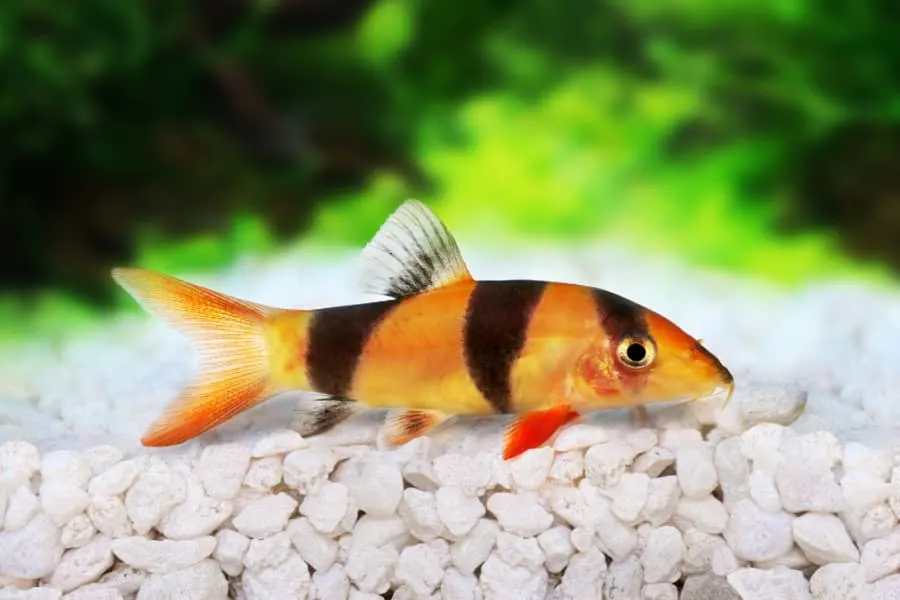
The Clown Loach is considered a poor choice for beginner aquarists. It’s an unfortunate fact that most Clowns don’t make it to adulthood due to their requirements being seldom met.
Anyone willing to keep this species should seriously consider the long-term commitment as they can get surprisingly large (almost the size of an American football) requiring an ever-increasing size of aquaria and may potentially live for many years.
Moreover, as a schooling fish, Clowns need to be in a group of 5+, resulting in a heavy bioload. To maintain cleanliness and optimum water quality, you will need robust filtration systems with a large turnover, additional powerheads for water movement, and frequent water changes.
As you can guess it’s quite an expensive hobby to raise Clown Loaches. Unless you are well-prepared to maintain a monster-sized aquarium for 10-20 years, abandon the idea of owning the Clown Loach.
Requirements For Setting Up Clown Loaches Aquarium
If you are wondering what makes up an ideal habitat for Clown Loaches, here you go:
Tank Size For Clown Loaches
A group of 6 juvenile Clown Loaches can be comfortably housed in a 75-gallon aquarium. This is the bare minimum for baby Clowns.
Although they grow fairly slowly and may take years to outgrow the mentioned size, eventually, at some point in time, you will need to upgrade to a larger tank as the Loaches turn into giants.
A habitat with ample swimming space and a lot of hiding places is essential for Clown Loaches. Keeping these botiids in the smaller tank will cause them stress, resulting in stunted growth, aggression, and odd behaviors.
Robust Filtration System & Heater Are Essential
Depending on the size of your aquarium and the number of inhabitants, you will need one or more filters to process the biological detritus. For efficient filtration, always go for the ones that offer a large turnover or are rated higher than your tank’s capacity.
A heater is another piece of equipment that is critical for the well-being of Clown Loaches. In the later section, we have shared the ideal temperature limit you need to maintain for your Loach aquarium at all times.
Get Power Heads For Water Movement
Being native to fast-moving streams, water movement is an intrinsic part of Clowns’ natural environment. They relish a fairly good water flow and also require high oxygen levels in their aquarium.
Depending on how much water movement your filter already produces, you may need multiple powerheads or airstones to achieve sufficient water currents to suitably replicate the natural habitat of the Clown Loach.
Numerous Hiding Spots & Subdued Lighting
The Clown Loach is a shy fish that loves to hide. Having provided a lot of hiding spots in the aquarium, makes the Clowns feel more secure, thus encouraging them to spend more time in the open.
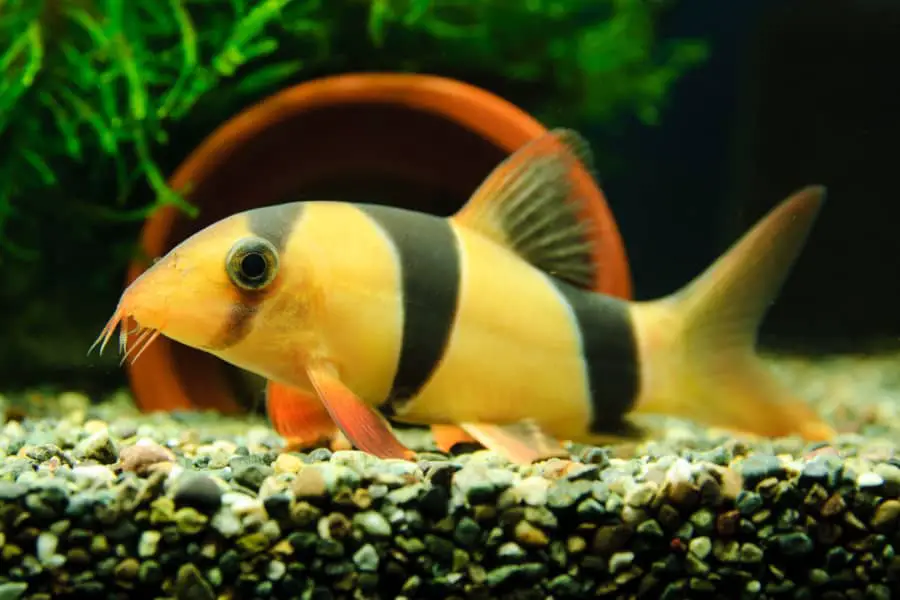
Various items such as shelter tubes, hollow driftwood, rocks, caves, or plants can be used to create hiding places or shaded areas for the fish to take refuge. This is a necessity for the Loach aquarium that shouldn’t be overlooked.
Also, keep in mind that bright lighting conditions can be stressful for the Clowns. So, always have subdued lighting in their tank, preferably with an addition of some form of moon lighting.
Ideal Water Parameters
- Clown Loaches aren’t particularly demanding in terms of water pH and hardness. They can adapt to a wide range of pH values from 6.5 to 7.5 and softer to moderately hard water.
- Water temperature needs to be between 80ºF to 86ºF (25-30°C)
Always keep the suggested water parameters as stable as possible. Too many fluctuations can stress out the fish and may lead to chronic health issues.
To attain excellent water quality in your aquarium, you need a robust filtration system accompanied by partial water changes. To avoid temperature or pH shock, the replacement water should be preheated and treated for at least 24 hours before a water change takes place.
NOTE 1: Clown Loaches aren’t suitable for newly set up aquariums because of their sensitivity to nitrates and other water pollutants. They should only be introduced to fully-cycled, established tanks.
NOTE 2: The Clown Loach is highly prone to ich (or white spot disease.) So, when you bring a new fish home, always isolate it in a quarantine tank before introducing it to the main tank.
Adopting this practice is of significant importance to prevent the spread of the disease.
Are Clown Loaches a Bad Choice For Planted Aquariums?
The Clown Loach is notorious for decimating planted tanks. Apart from their affinity for digging and uprooting plants, Clown Loaches enjoy punching holes in the leaves and sometimes biting off the entire leaf off the stems.
Young Loaches are nearly harmless and can be kept in a densely planted aquarium. But, as they get bigger and more powerful, they will start digging around destroying the plants, even wrecking the ones that are well-rooted.
Reportedly, even the plants with a bitter taste (such as Anubias and Java Fern) couldn’t escape the Clown’s punishment.
From our own experiences and those of other aquarists, we have concluded that it’s really difficult to have a planted aquarium with adult Clown Loaches.
However, there is an experiment that has shown promising results to some Loach owners. It includes feeding more vegetables to the fish to help naturally decrease their appetite for plant matter.
Keep in mind that complying with the above practice may or may not change the inquisitive, plant-demolishing, and eating behavior of your Clown Loach. But it’s certainly worth trying.
Lastly, here are some of the low-light aquarium plants that have some success withstanding the Clowns:
- Crinum Calamistratum
- Crypts
- HC Cuba
- Glosso
- Hygrophila
- Ludwigia
NOTE: To prevent and safeguard young plants from uprooting, tie them to heavier objects in the tank or put rocks around them until the roots get a hold.
How Many Clown Loaches To Keep Together?
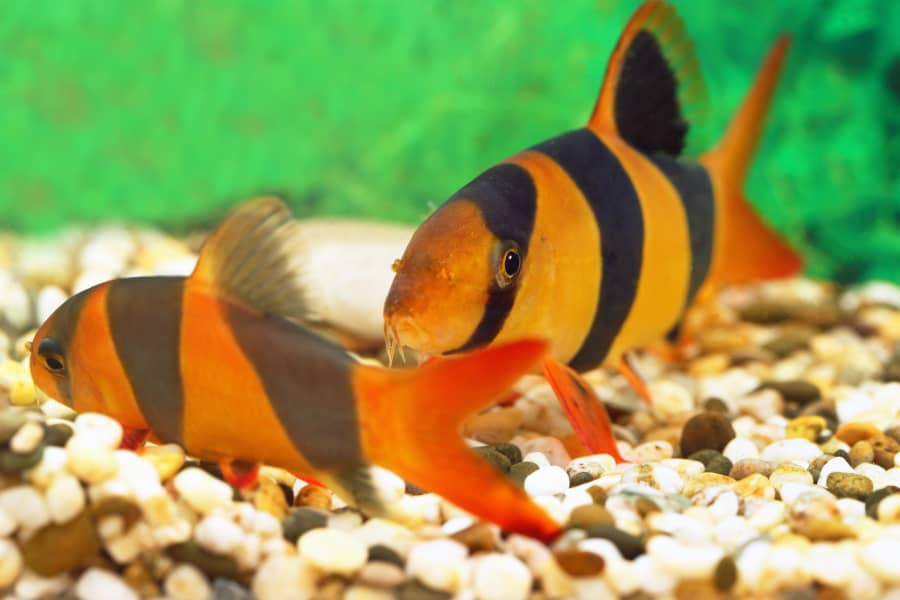
As a social and schooling fish, Clown Loaches thrive in a group. They are often sold as trios, believing that somehow it would be enough. However, that’s not true.
The bare minimum recommendation for a Clown Loach group is 5, though more are preferable.
Being shy fish, if they don’t get enough friends (of their kind) to hang out with, they will experience stress. And as a result, may resort to hiding.
Isn’t it a shame to have such beautiful fish and never get to see them?
Compatible Tank mates for Clown Loaches
If you can’t keep a giant group of Clown Loaches, try stocking a bunch of dither fish. These are social and outgoing fish that actively swim in the open. They make the shy fish feel safer and reduce their timidity, thus encouraging them to come out of hiding.
Rainbow fish, Congo Tetras, and Tiger Barbs are some of the best options to choose from. Due to the similar stripe pattern, Clown Loaches and Tiger Barbs are more likely to school together, especially if they are of the same size.
NOTE: Although Clown Loaches don’t typically hunt other fish, if given an opportunity they will unhesitatingly make a snack out of smaller fish and invertebrates.
What To Feed Clown Loaches?
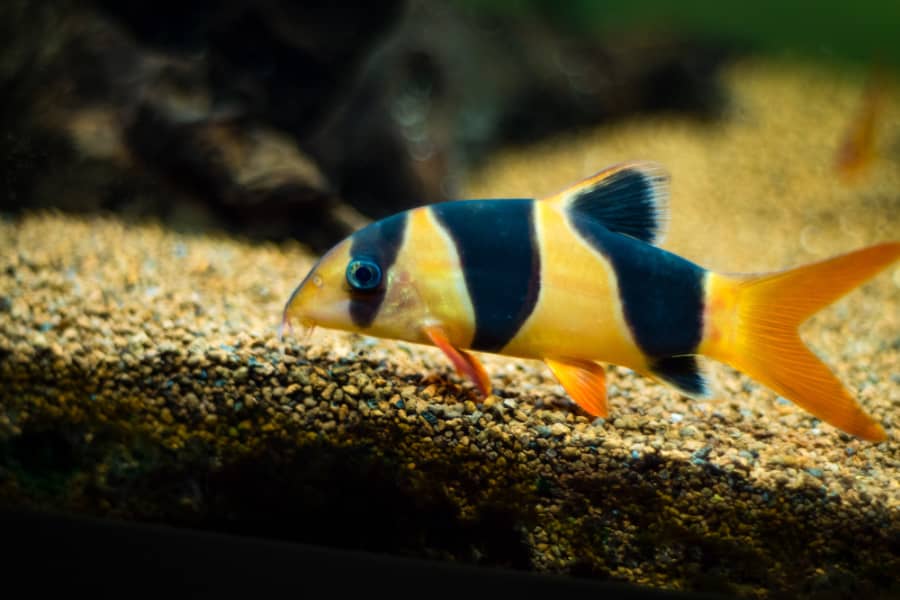
Clown Loaches are omnivores, implying they eat both meat and plant matter. The best part is they are not picky eaters and will eat about anything or everything you offer them.
- Clown Loaches absolutely relish ranges of insects such as frozen bloodworms, tubifex worms, mosquito larvae, brine shrimp, and crustaceans.
- For the staple, you can feed commercial fish foods such as high-quality flakes, wafers, or sinking pellets formulated for omnivorous fish.
- Clowns also like munching on blanched vegetables such as cucumber, zucchini, peas, squash, potato, or melon.
As you can see, there are a lot of options to choose from. A well-balanced diet for Clown Loaches includes a high-quality staple fish food (or a few different ones), worms of some form, and a fair amount of vegetables.
NOTE: Clown Loaches are kept at a temperature that’s hotter than usual, resulting in increased metabolism. You should feed them a decent amount of food to make sure they aren’t underfed.
Why Clown Loaches Are Always Hiding?
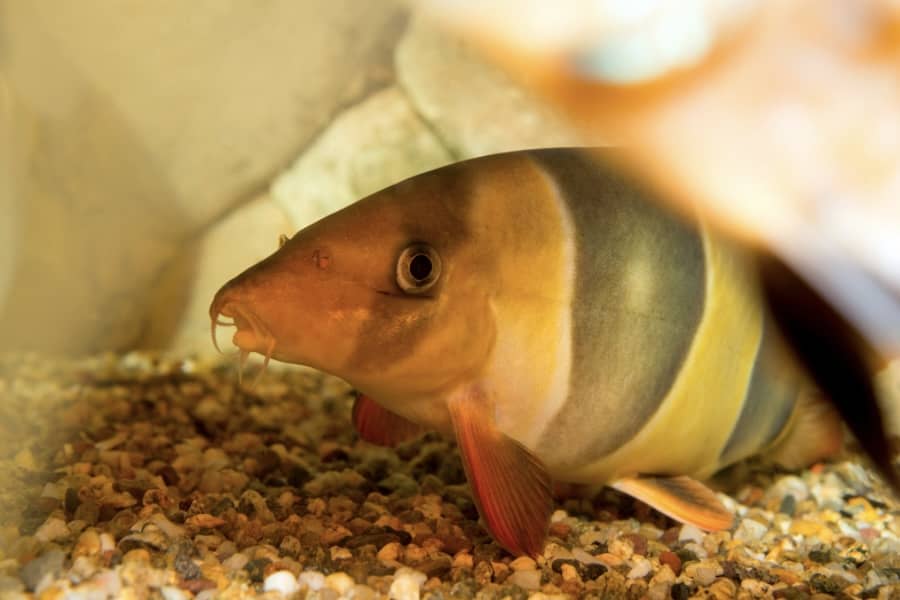
A Clown Loach Hiding
For a naturally skittish fish like the Clown Loach, hiding is normal behavior. However, if your fish is overdoing it and barely comes out in the open, there can be one of the following factors responsible for such an act.
Stressed From Transportation
Moving can be a traumatic experience for Clown Loaches or any other fish for that matter. If you have recently brought the fish home, give it some time to recover from the stress and get acclimatized to its new surroundings.
A fish may take varying periods of time to be completely settled; sometimes weeks, so be patient. It’s always worth the wait.
Lack of Company
The Clown Loach is a schooling fish that needs to be in a group of 5+ to feel comfortable swimming around a tank.
If your Clown Loach doesn’t have enough buddies of its own species, the hiding behavior is quite understandable. Getting more Clowns should solve this problem, as long as you have enough room for them.
However, if you don’t want to stock more Loaches, stocking a bunch of dither fish also helps.
Noticing these small fish fearlessly cruising around the tank, all the time, will make the Clown Loach feel secure and they are likely to come out more
Bright Lightings
Intense lighting conditions are simply discomforting to Clown Loaches. So, consider dimming the light or shading it with floating plants. You can also use Indian almond leaves to naturally stain the water with tannins, which makes it harder for the light to penetrate the water.
Moreover, Clown Loaches are semi-nocturnal – meaning, they tend to be more active during dawn and dusk when the sun isn’t as bright. For that reason, we suggest getting an LED moonlight.
It is used to facilitate a smooth transition between dawn and dusk. It prevents the fish from getting shocked by a sudden change in the brightness.
Lack of Hiding Spots
Now, you might say that your fish is already hiding, what do you need more hiding places for?
Ironically, the more hiding spots there are in the tank, the more relaxed and safe Clown Loaches feel. Knowing that safety is near and they can dart whenever required, makes the fish come out more often, allowing them to explore and venture.
Given you have a spacious aquarium, try adding pieces of bogwood, plants, coconut caves, and plenty of hides to make your Loaches feel secure.
What Causes Clown Loaches Color to Fade?
Clowns possess the ability to change their coloration based on mood, aggression, stress, and other likewise factors.
Clown Loaches “Graying Out”
Typically, the graying out phenomenon in Clown Loaches is to establish a natural pecking order within the group. It’s to state dominance.
The momentarily fade in color is commonly noticed during disputes. And particularly at feeding time, when many squabbles break out, the dominant (alpha) fish will turn gray at the drop of a hat to show who is the boss of the tank.
Clown Loaches Turning Pale
If your fish looks paler than its regular coloration, it’s probably due to stress.
The common stressors for Clown Loaches include lack of hiding places, not enough buddies to form a school, inappropriate temperature, bright lighting, or higher ammonia/nitrite concentration.
You need to act quickly to identify and eliminate the source of stress, especially if your Clown has been in its paler look for a prolonged time.
The Reason Behind Clown Loach Swimming Awkwardly
There can be multiple reasons for the Clown Loach to swim erratically. It’s almost impossible to pinpoint a cause without checking into the tank conditions and fish health.
Generally, it’s a typical behavior for a Clown Loach to swim up and down the aquarium. As long as the water parameters are up to the mark, your fish is eating well, and has no visible symptoms, there is nothing to worry about.
However, if the weird swimming behavior is accompanied by rapid/heavy breathing, listless or lethargy, loss of appetite, or pale color, then it’s a clear indication that something is wrong in your aquarium.
Before you do anything to diagnose the issue, first rule out the possibility of poor water quality. Using the API Master Test Kit test your tank water. Ideally, ammonia and nitrite should be at 0 ppm and nitrate less than 20 ppm.
If the water seems fine, then perhaps it’s a bacterial or parasitic infection (especially, if the fish is flicking a lot) that’s causing your Clown stress and discomfort.
Swimming on the Surface
It’s a tell-tale sign of a lack of oxygen in the water. Being a river-dwelling fish, Clown Loaches need high oxygenation levels. If they don’t get the required amount, they will come to the surface gasping for air.
In this case, you need to install some powerheads in your tank.
Clown Loach Lying On Its Side – What’s The Catch?
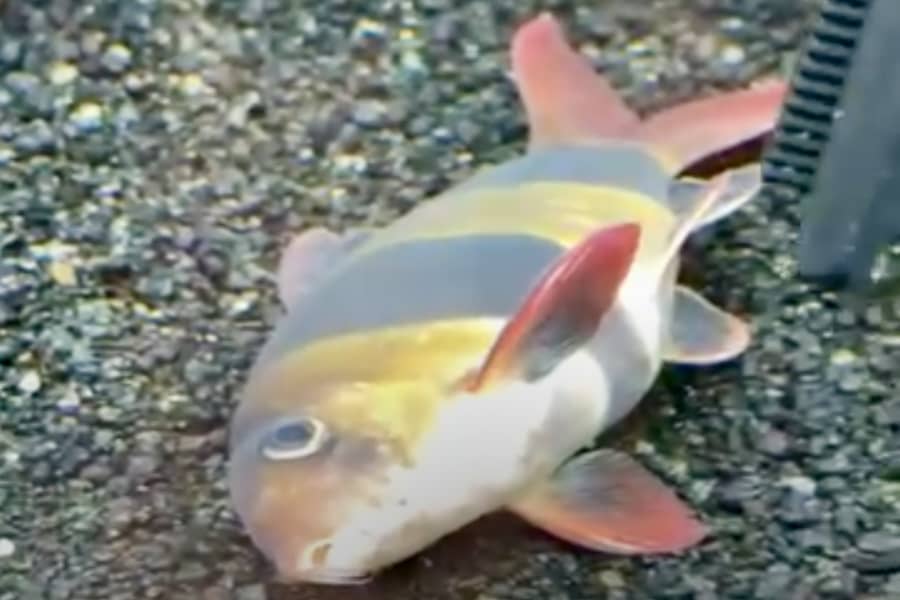
While it may seem unusual or even quite alarming to find your fish lying on its side motionless, it’s pretty normal behavior for a Clown Loach to engage in. This is just Clowns being clowns.
Although unfishlike manner, Clowns often spend time sleeping or resting in unusual positions, pretty much “playing dead”. You may get scared the first time you see it but know, there is nothing to be alarmed of.
If you ever find your Clown lying on the side, don’t reach out to correct its posture. Because it may freak out the fish, giving a mini heart attack to the little creature, and causing unnecessary stress.
Common Health Problems Clown Loaches Are Most Prone To
Clown Loaches are particularly susceptible to Ich (or white spot disease) and Skinny disease. The following sections will walk you through each of the diseases, shedding light on their causes, symptoms, and effective remedies.
Ich – The White Spot Disease
Being a small-scale fish with a naturally nervous disposition, it’s no surprise that Clown Loaches are highly susceptible to ich infestations.
The common symptoms of Ich include tiny white dots on the body or gills, flashing, labored breathing, and loss of appetite.
There are three methods to cure Ich and all are effective. You can use commercial ich medication, salt, or the heat method. Whichever method you choose, make sure to change 50% water every two days and most importantly vacuum the bottom.
NOTE: To safeguard your aquarium and its inhabitants from deadly infections like ich, always quarantine a new fish for at least 3 weeks.
Skinny Disease
This disease is often caused by internal parasites and is prevalent in newly imported fish. It manifests exactly as it sounds like, causing the fish to constantly lose weight regardless of how much food it eats.
Levamisole, Metronidazole, and PraziPro are the most recommended medications for treating skinny disease in Clown Loaches.
Conclusion
Raising Clown Loaches is undoubtedly a highly rewarding hobby, but an expensive one. If you are certain that you can handle these large-bodied, slow-growing, and longer-living botiids, every investment is worth making.
